By Dr. Maddie Swannack and Dr. Sachin Sudhakaran
Next Lesson - Ear Pathology
Abstract
- The ear can be split into three sections: external, middle and inner ear.
- The external ear includes the pinna and the external auditory meatus.
- The tympanic membrane (or ear drum) divides the external and middle ear, and transmits vibrations caused by sound to the ossicles.
- The ossicles are tiny bones in the middle ear, which transfer vibrations along to the cochlea via the oval window. The Eustachian tube connects the middle ear to the nasopharynx.
- The oval window divides the middle and inner ear.
- The transmitted vibration causes movement of the cochlear fluid, stimulating the stereocilia (stereovilli), which generates action potentials along the vestibulocochlear nerve.
- Hearing problems can be conductive (relating to the external or middle ear) or sensorineural (relating to the inner ear or the vestibulocochlear nerve). These can be differentiated between using Weber’s and Rinne’s tests, with a 512Hz tuning fork.
Core
The ear is the human organ of hearing and balance. The anatomy of the ear can be organised into the external, middle and inner ear. This article aims to outline the key anatomical features.
This article will cover the basic structure and function of the ear. See our article on pathologies of the ear here.
This image shows the basic anatomy of the ear. Note the three segments of the ear.
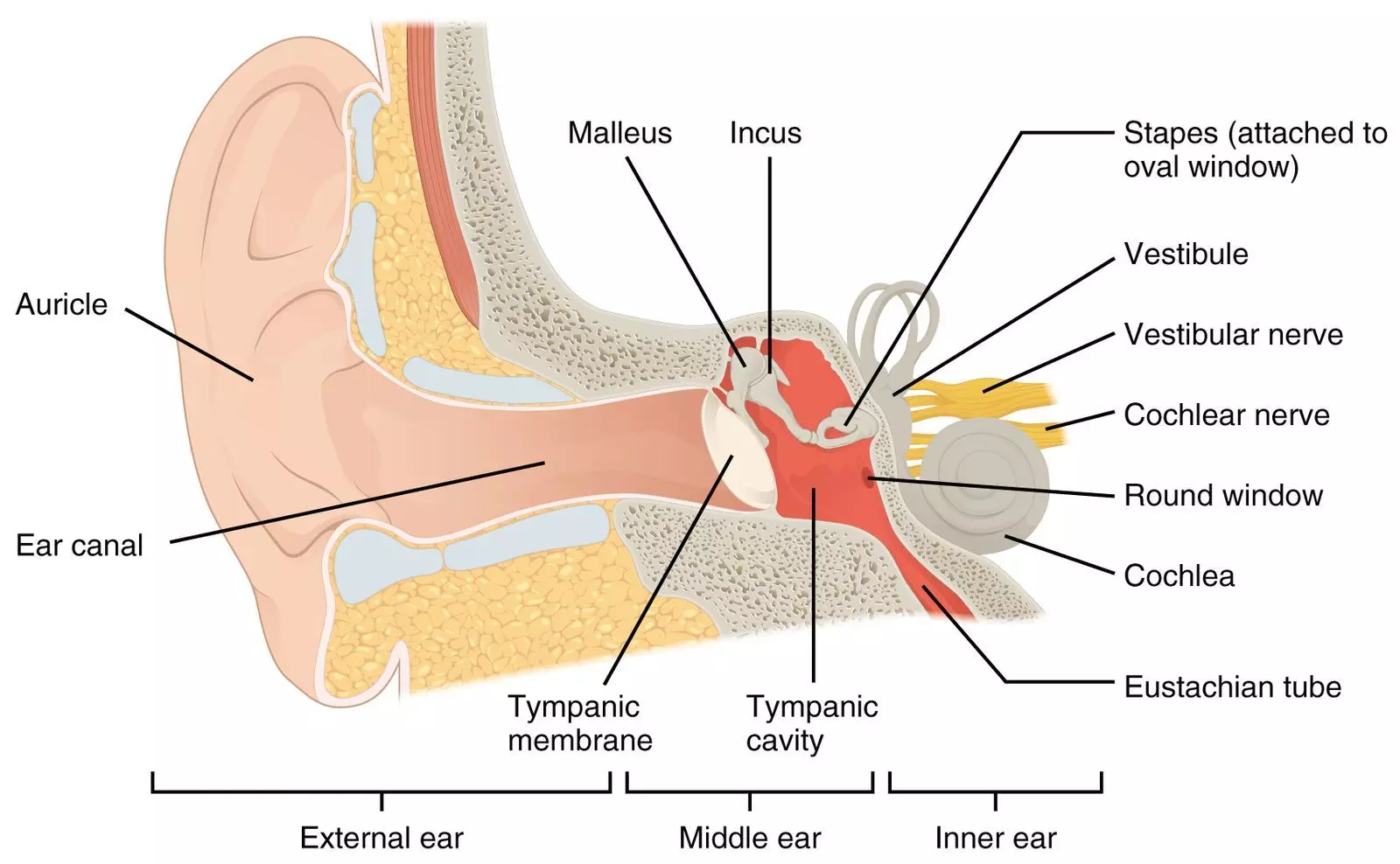
Diagram - General overview of the anatomy of the ear
Creative commons source by OpenStax [CC BY-SA 4.0 (https://creativecommons.org/licenses/by-sa/4.0)]
The external ear can be divided into the pinna and external acoustic meatus.
The pinna is a structure found on the side of the head that acts to direct sound waves toward external acoustic meatus. The majority of the pinna is cartilaginous (elastic cartilage). Helpful structures to remember are the tragus, helix, concha and lobule. The pinna has a number of parts as demonstrated in the image below:
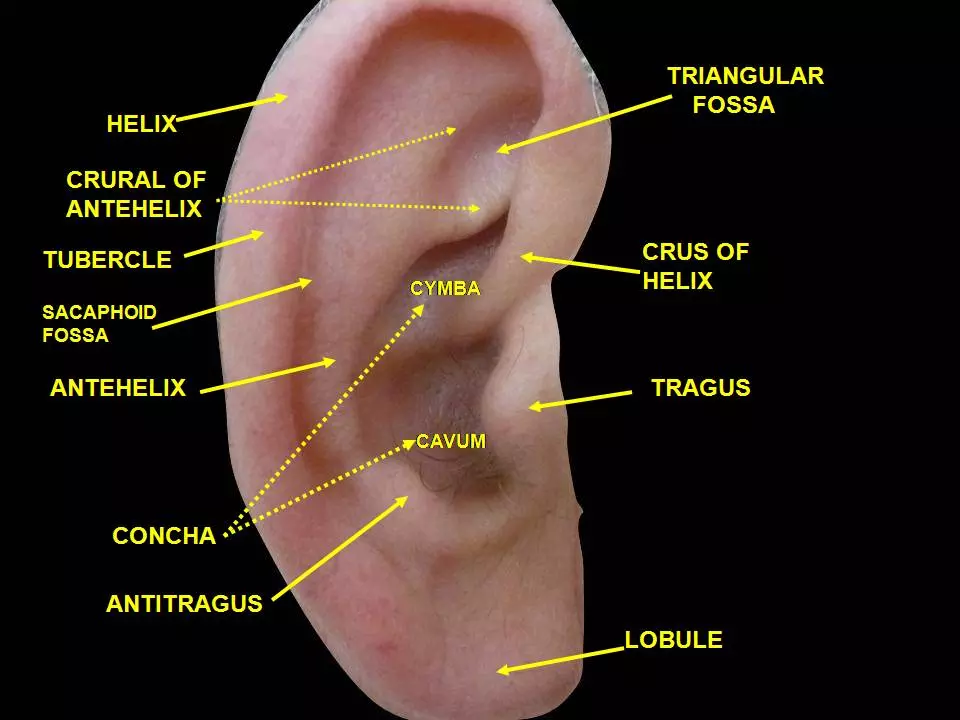
Diagram - Anatomy of the pinna
Creative commons source by Anatomist90 [CC BY-SA 4.0 (https://creativecommons.org/licenses/by-sa/4.0)]
The external acoustic meatus (EAM) (ear canal) is a s-shaped tube which extends from the pinna to the external surface of the tympanic membrane. The walls of the outer 1/3 of the canal, are formed by cartilage whilst the walls of the remaining inner 2/3 are made up of the temporal bone.
The sigmoid shape is clinically relevant as it can have implications on otoscopy. If the tympanic membrane is not immediately visible, gently pulling the pinna in a posterior and superior direction can straighten the meatus and allow the ear drum to be visualised.
The EAM is lined with keratinised, stratified squamous epithelium like most skin. The canal is usually self-cleaning with shed epithelium moving out through the canal. This shedding of the epithelium helps to remove ear wax, which exists to clean and lubricate the ear. Ear wax is made up of epithelial cells, lysosomes and oil. The wax has a low pH to inhibit bacterial growth and is hydrophobic to try to reduce water in the outer ear.
The tympanic membrane (TM) is found at the medial end of the external acoustic meatus. It is usually translucent and on otoscopy, some structures of the middle ear can be observed through it.
The presence of the cone of light (a reflection from the otoscope) indicates that the tympanic membrane is a normal concave position.
The tympanic membrane is key to hearing. It converts sounds (vibrations in the air) into vibrations of the membrane which can then be transmitted along the ossicles.
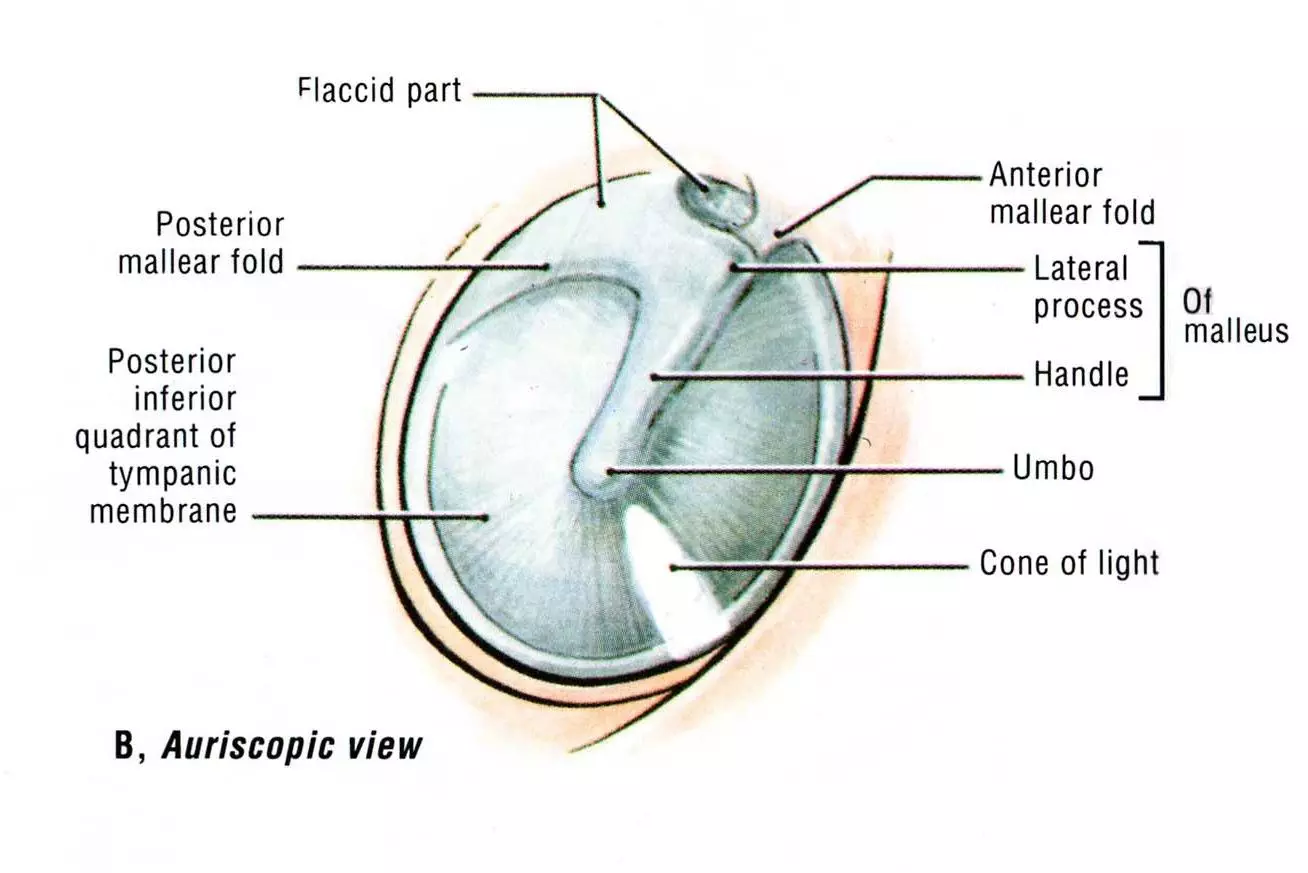
Diagram - The tympanic membrane of the right ear. Note the cone of light, and the lateral process and handle of the malleus (of the middle ear)
Creative commons source by EMAD KAYYAM [CC BY-SA 4.0 (https://creativecommons.org/licenses/by-sa/4.0)]
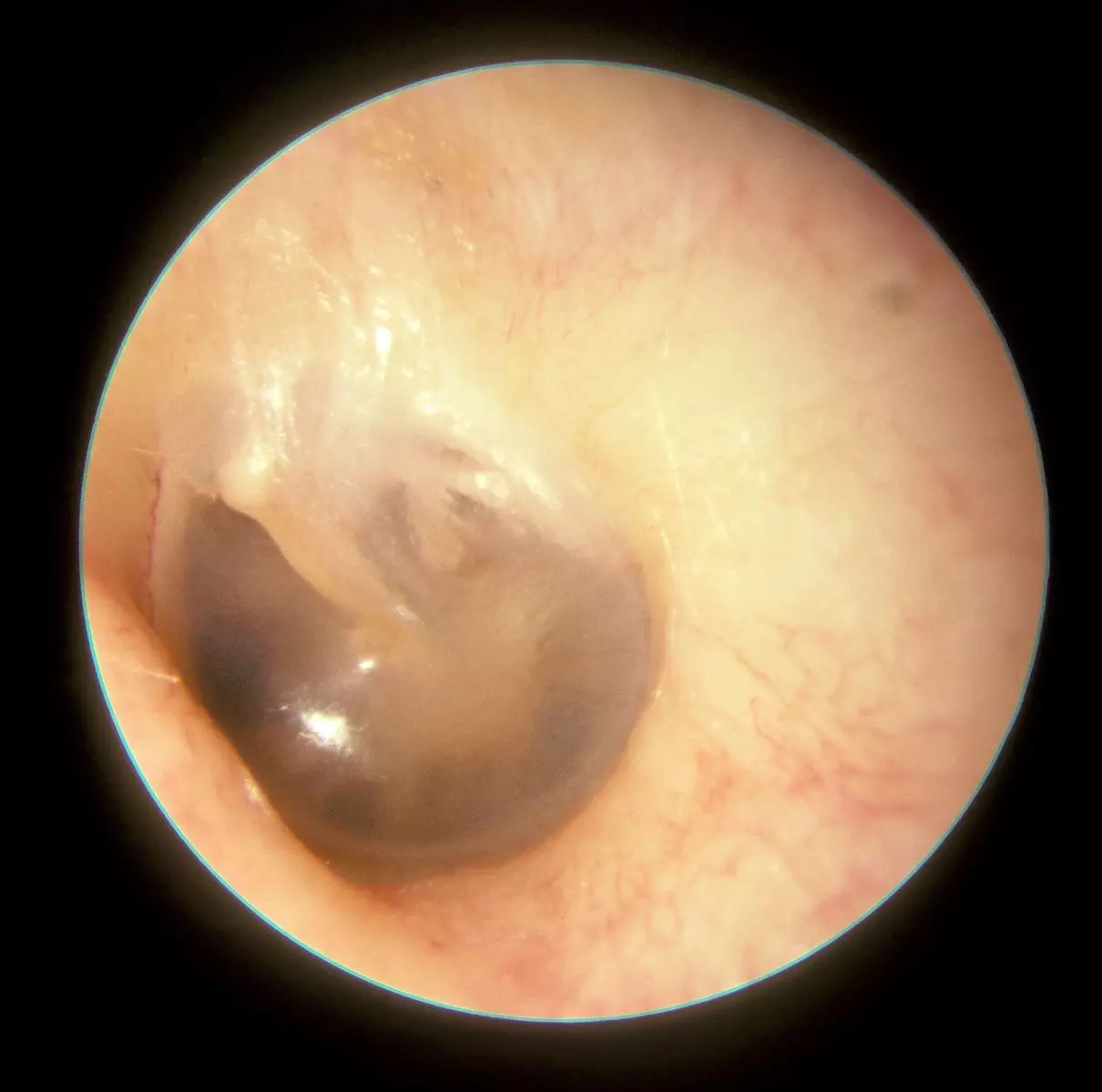
Image - The tympanic membrane of the left ear on otoscopy. This is the normal colour for the tympanic membrane, and there is no fluid level visible (which would indicate an abnormal collection of air or fluid in the middle ear)
Creative commons source by Michael Hawke MD [CC BY-SA 4.0 (https://creativecommons.org/licenses/by-sa/4.0)]
The middle ear is an air filled cavity which lies within the temporal bone, extending from the tympanic membrane to the lateral inner ear.
The facial nerve passes through the middle ear cavity. As a result, pathology in the cavity can cause symptoms relating to the facial nerve.
The middle ear contains three ossicles: the malleus (hammer), the incus (anvil) and the stapes (stirrup). These relay vibrations from the TM to the oval window of the cochlea of the inner ear.
The strength of vibration can be dampened by the tensor tympani and stapedius muscles which lie in the middle ear.
The order of the ossicles can be remembered by remembering that the Malleus is at the tympanic Membrane (2 Ms together), and the order spells MIS or that a hammer is used on an anvil to make stirrups.
Eustachian Tube (Pharyngotympanic Tube)
The Eustachian tube is a communication from the middle ear to the nasopharynx which allows for equalisation of pressure within the middle ear. This is required as the middle ear is lined with a mucous membrane which continuously resorbs air, resulting in a negative pressure inside the middle ear (shown by the concave tympanic membrane) compared to the atmosphere. The Eustachian tube facilitates a relative equalisation of this pressure gradient (stops the gradient getting too steep).
However, the Eustachian tube can act as a passage for infections of the nasopharynx to pass into the middle ear and cause infection there. This is more common occurrence in children as their Eustachian tubes shorter and have a flatter course within the skull. This means that mild infections like colds are more likely to cause middle ear infections in children. As the skull increases in size, the Eustachian tube takes on a steeper angle and lengthens, meaning that infections of the nasopharynx are less likely to pass into the middle ear in adults.
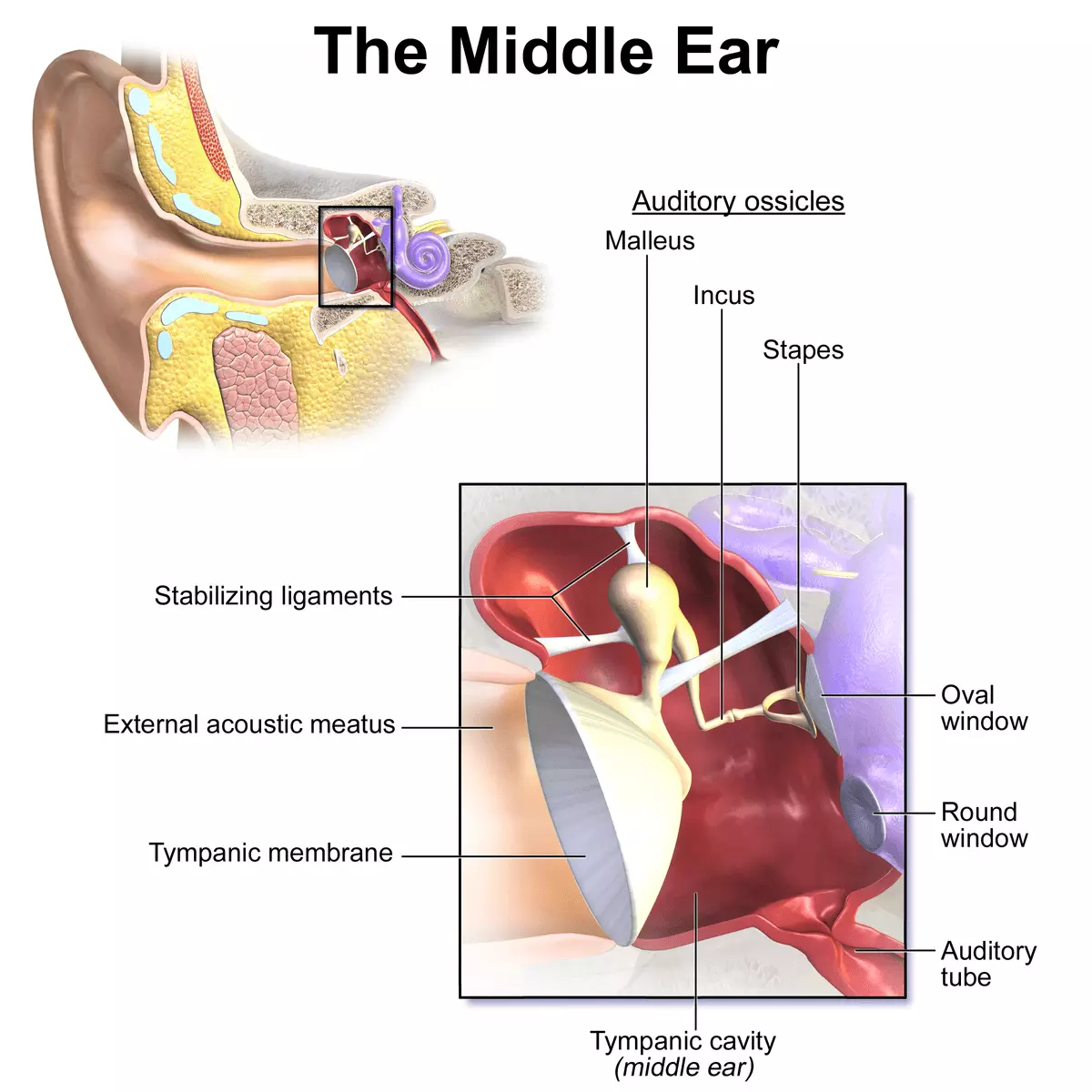
Diagram - The anatomy of the middle ear
Creative commons source by BruceBlaus [CC BY-SA 4.0 (https://creativecommons.org/licenses/by-sa/4.0)]
The inner ear contains two key organs: the vestibular apparatus and cochlea.
Vibrations passing through the ossicles in the middle ear result in movement of the oval window (part of the cochlea) causing movement of the fluid within the cochlea. This movement of fluid causes movement of stereocilia on the walls of the cochlear duct. Movement of the stereocilia generates action potentials which propagate through the cochlear portion of cranial nerve VIII (vestibulocochlear nerve). The cochlea also has a structure called the round window. This structure can compensate for the movement of fluid within the cochlea as a result bulging out when the oval window is compressed.
The vestibular apparatus uses the position of fluid within three semi-circular canals (anterior, lateral and posterior) to maintain a sense of balance. Movement of the head leads to movement of stereocilia within these structures, leading to action potentials to propagate through the vestibular portion of cranial nerve VIII.
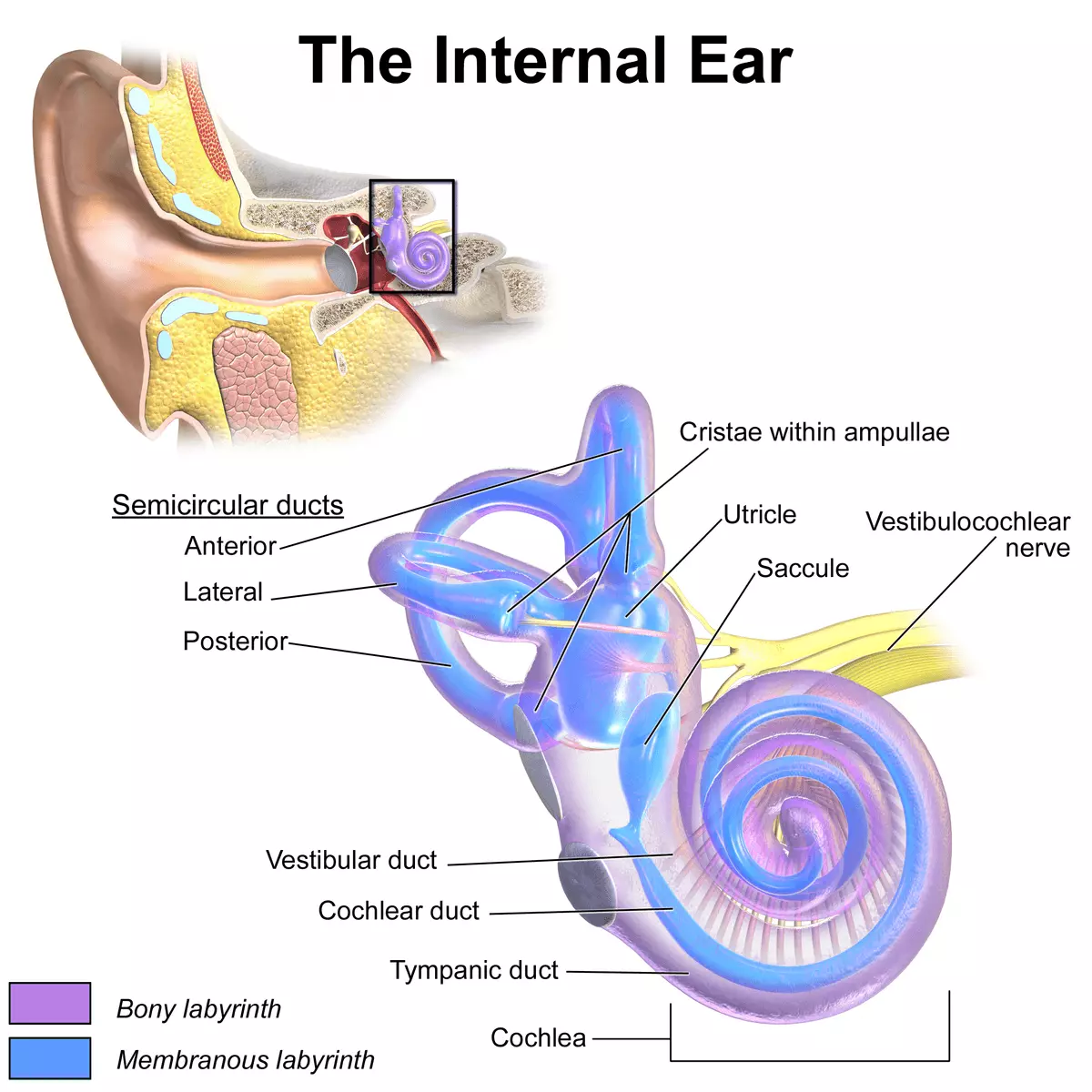
Diagram - The anatomy of the inner ear
Creative commons source by BruceBlaus [CC BY-SA 4.0 (https://creativecommons.org/licenses/by-sa/4.0)]
The process of hearing is quite simple:
- The pinna and the external auditory meatus focus and funnel sound onto the tympanic membrane, which vibrates when sound hits it.
- The vibration of the tympanic membrane vibrates the ossicles.
- The vibration of the stapes at the oval window causes movement in the cochlear fluid.
- This movement of the fluid stimulates the stereocilia in the cochlea.
- Stereocilia then trigger action potentials in the vestibulocochlear nerve.
- Impulses travel to the primary auditory cortex (in the temporal lobe), which interprets the input.
There are two main causes of hearing loss related to specific structures of the ear.
The first is conductive hearing loss – this is pathology of the outer or middle ear and causes problems with the transmission of sound wave vibrations to the cochlear. Air conduction of sound will be impaired as sound is not transmitted. However, as the cochlea is preserved bone conduction will be unaffected or even enhanced as the ear will not be able to hear any distracting sound transmitted through the ear.
The second is sensorineural hearing loss – this is pathology of the inner ear or the vestibulocochlear nerve. This is due to defects with the transmission of the impulses from the stereocilia. Both air and bone conduction of sound will be reduced as the cochlea or nerve are damaged so sound cannot be transmitted appropriately to the brain.
Hearing tests with tuning forks can help to differentiate between these two types of hearing loss.
Examination of Hearing in General Practice
If a patient presents with concerns about their hearing, there are a number of things which can be done to elucidate its cause and treatment:
History
It is important to take a full history of the hearing loss with specific focus on the development of the issue, the exact nature of the patient’s concerns, and any other ear related symptoms (such as vertigo, discharge from the ear or tinnitus).
It is also important to establish whether the patient thinks the hearing problems are bilateral or unilateral, as this can help differentiate the causes of the deficit.
As always ensure to establish wider history including, medication history, past medical history, any occupational exposure to loud noises or family history of hearing issues.
Visual Examination
Examination of the external ear and otoscopy to visualise the tympanic membrane should be attempted.
Gross Hearing Assessment
A crude test of hearing should be performed on every patient who presents with concerns. One example of how to complete this would be to whisper a number into a patient’s left ear while masking the right ear (for example by crumpling paper next to their right ear) and then asking the patient to speak the number. By repeating this bilaterally, it might give an indication if the hearing is better on one side or the other, or if both are impaired equally.
Tuning Fork Tests
There are two tests performed as an assessment of hearing using tuning forks.
A tuning fork is an instrument that produces vibrations at a specific frequency when struck, creating a noise. It can be used in two tests to assess hearing.
To perform these tests, a tuning fork of 512Hz should be used.
To conduct Weber’s test, the tuning fork is struck and is placed in the centre of the forehead. The patient is asked if it sounds louder in either ear.
- A normal result is that the sound is equally loud in both ears.
- An abnormal result is that the sound localises to one ear.
If the hearing loss is sensorineural, the louder ear will be the normal ear. This is as all interpretation of sound is lost in the pathological ear.
If the hearing loss is conductive, the louder ear will be the pathological ear. This is as bone conduction is enhanced in the absence of air conduction.
Weber’s test is used in conjunction with Rinne’s test to confirm whether hearing loss is sensorineural or conductive.
The second test is called Rinne’s test and is a conduction test.
The tuning fork is struck and placed on the mastoid process (the bony area just behind the ear). The patient is asked to indicate when they can no longer hear the sound of the fork. At this point, the tuning fork is moved to in front of the pinna, and the patient asked if they can hear it now.
A normal result is that the patient can hear the noise of the fork through the air after they have ceased to hear it through the bone – so air conduction > bone conduction. This is a positive Rinne’s test and is normal.
A patient with conductive hearing loss will have bone conduction > air conduction because their ear canal or middle ear is not transmitting vibrations to the cochlea whilst the mastoid bone still can as the cochlea is undamaged.
A patient with sensorineural hearing loss will also have a Rinne’s positive result as both air and bone conduction will be reduced equally and therefore it will still be the case that air conduction > bone conduction.
This is why combining the tests is vital to achieve a diagnosis.
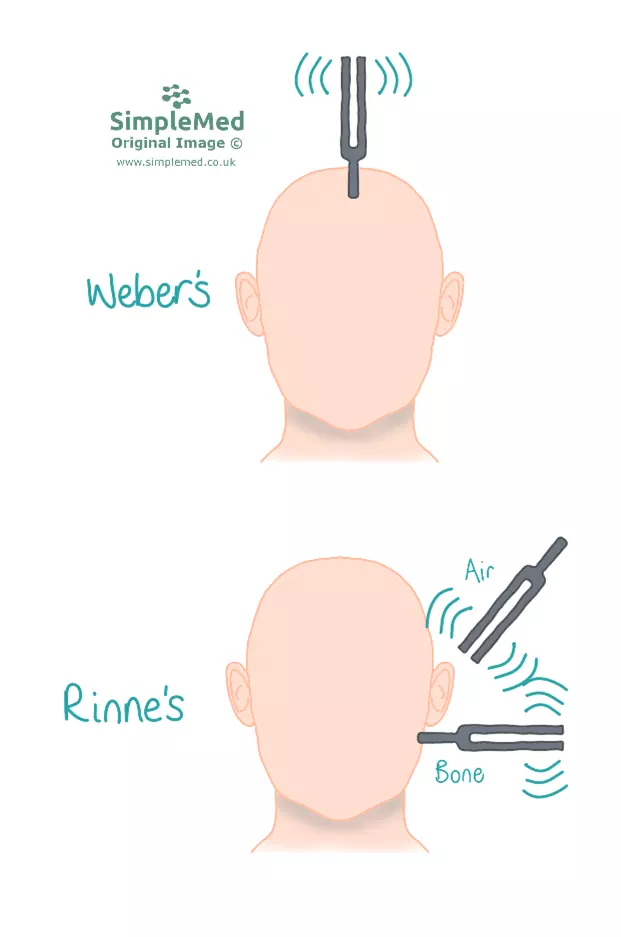
Image - The different positions of the tuning forks in Weber’s and Rinne’s tests
SimpleMed original by Maddie Swannack

Table - The results of Weber's and Rinne's Tests
SimpleMed original by Maddie Swannack
It can be easy to confuse these tests and their results without context. The best way to help understand them is through examples.
Patient 1
Patient 1 has presented to the GP with reduced hearing in his right ear after a head cold. After taking a history the GP examines the patient and conducts Rinne and Weber’s tests. Patient 1 after gross hearing test confirms that hearing is reduced in his right ear.
Patient 1 says that Weber’s test is louder in his right ear. This means that either he has sensorineural hearing loss on the left side, or conductive hearing loss on the right side.
Rinne’s test on the right side is negative (bone > air). This means that the right ear has conductive hearing loss. This makes sense in the context of Weber’s test; conductive hearing loss has increase bone conduction making Weber’s louder in his right ear.
After combining Weber and Rinne’s test the diagnosis is clear: right ear conductive hearing loss, left ear normal.
Patient 2
Patient 2 has presented to the GP after noticing reduced hearing in her left ear after a previously treated and resolved head injury. After taking a history the GP examines the patient and conducts Rinne and Weber’s tests. Patient 2 after a gross hearing test confirms that hearing is reduced in their left ear.
Patient 2 says that Weber’s test is louder in her right ear. This means that either she has sensorineural hearing loss on the left side, or conductive hearing loss on the right side.
Rinne’s test on the right side is positive (air > bone) this makes right sided conductive loss unlikely.
Rinne’s test on the left side is positive (air > bone). This means that the left ear is either normal or has sensorineural hearing loss. When combined with the results of Weber’s test and the gross hearing test it confirms that there is sensorineural hearing loss in the left ear.
In summary: conductive hearing loss has been ruled out with bilateral Rinne’s positive results, with Weber’s indicating sensorineural hearing loss on the left side.
These tests are a good indicator of the need for further investigation – a referral for a formal hearing assessment should be made if any abnormalities are found on either Rinne’s or Weber’s tests.
Edited by: Dr. Ben Appleby
Reviewed by: Dr. Thomas Burnell
- 2880

